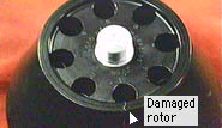| Page 3 |

|
|
1 - CENTRIFUGE SAFETY
2 - Page 2 3 - Page 3 4 - Page 4 |

 HOME
HOMEOnce the centrifuge run is complete, make sure the rotor has STOPPED completely before you open the centrifuge lid; then check for spills. If infectious material was placed in the centrifuge, WAIT 10 minutes before opening the centrifuge lid. If leak or damage has occurred, close the lid and plan proper decontamination and cleanup.
Maintenance/Cleaning:- Keep rotors clean and dry. If spills occur, make sure rotor has been cleaned/decontaminated. If salts or corrosive materials were used, ensure they have been removed from the rotor.
- Avoid mechanical scratches. The smallest, scarcely visible scratch allows etching to enlarge the fracture, which is subject to enormous rupturing forces at high g's--a vicious cycle leading to rotor explosion.
- Avoid bottle brushes with sharp metal ends and harsh detergents when cleaning aluminum rotor heads.
- After proper clean-up, rinse the rotor with de-ionized water.
- Check the rotor for rough spots, pitting, and discoloration. If discovered, check with the manufacturer before using. Use professional rotor inspection services frequently. These visits can be arranged to accommodate numerous users throughout the facililty.
- Consult the centrifuge manufacturer and centrifuge log for the derating schedule for the rotor. Remember--an unlogged ultra-speed centrifuge is a ticking time bomb.
 |
| << Previous 1 2 [3] 4 Next >> |
